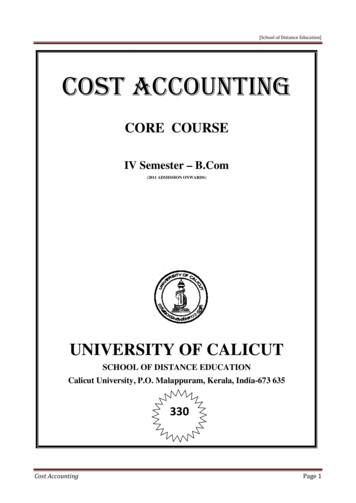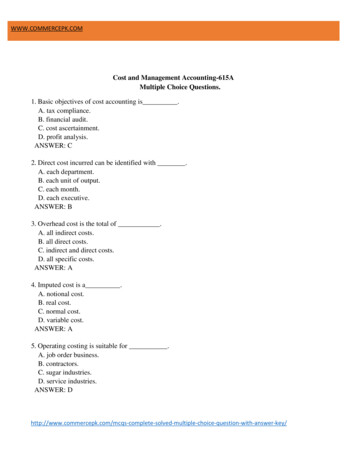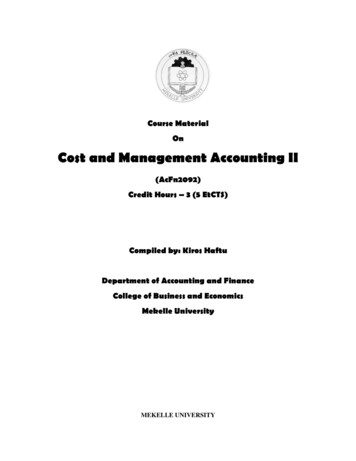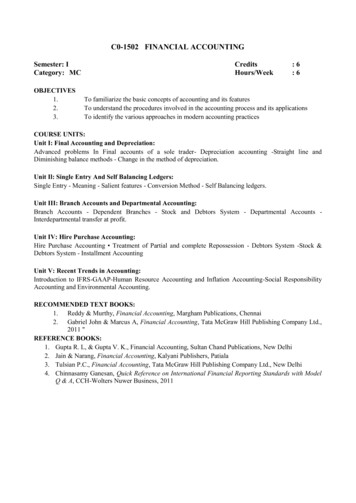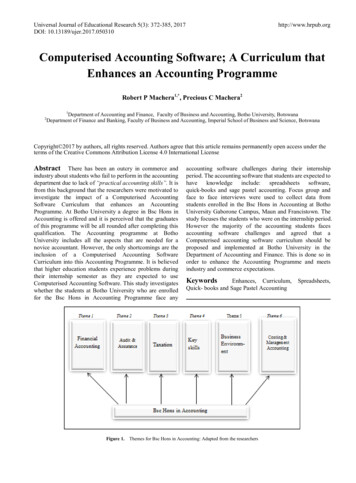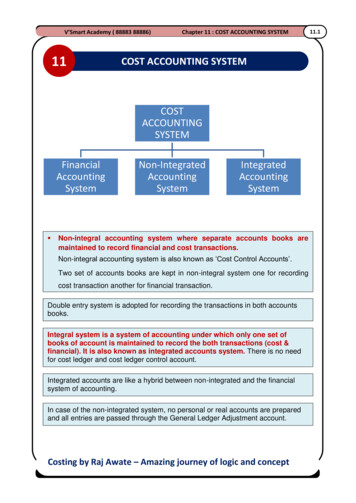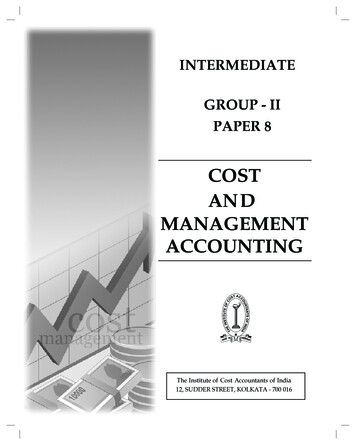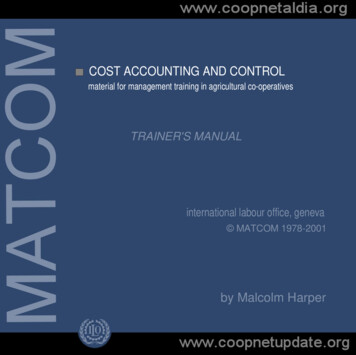
Transcription
COST ACCOUNTING AND CONTROLmaterial for management training in agricultural co-operativesTRAINER'S MANUALinternational labour office, geneva MATCOM 1978-2001by Malcolm Harper
MATCOMMaterial and techniques for cooperatives 8bytheInternational Labour Office, with the financial support ofSweden. In its third phase (1984-1986) MATCOM is financedby Denmark, Finland and andtraining institutes in all regions of the world, MATCOMdesigns and produces material for the training of managersof cooperatives and assists in the preparation of adaptedversions for use in various countries. MATCOM also providessupport for improving the methodology of cooperativetraining and for the training of trainers.Publications of the International Labour Office enjoycopyright under Protocol 2 of the Universal CopyrightConvention. For reproduction, adaptationor erland. The International Labour Office welcomes suchapplicationsCopyright International Labour Organization
IPrefaceThis training package is one of a number of training packages designedby the ILO-MATCOM Project to assist people who plan or carry out training for the managerial staff of agricultural co-operatives in developing countries.The training provided under this training package, as well as under theother packages in this series, is based on a thorough analysis of:(i)the tasks and functions to be performed in agricultural co-operative societies in developing countries;(ii)the common problems and constraints facing the effective performance of these tasks and functions.The result of this analysis is reflected in the MATCOM "CurriculumGuide for Agricultural Co-operative Management Training".The Guidecontains syllabuses for 24 management subjects and MATCOM has producedtraining packages, similar to this manual, for the following subjects:-Collecting and Receiving Agricultural Produce-Transport Management-Storage Management-Marketing of Agricultural Produce-Supply Management-Rural Savings and Credit Schemes-Staff Management-Financial Management-Cost Accounting and Control-Risk Management-Project Preparation and Appraisal-Work Planning-Export Marketing-Management of Larger Agricultural Co-operativesFor more information on the above training material, please write to:The MATCOM Projectc/o CO-OP BranchInternational Labour OfficeCH 1211 Geneva 22Switzerland.
IITHE TRAINING PROGRAMME1.The Target GroupThis training programme is designed to assist in the training ofanyone who has responsibility for cost accounting and control inagricultural co-operative societies.This may include co-operativeadvisors and auditors, managers, assistant managers, accountantsand other staff who are involved in this activity.2.AimThe aim of the programmis to enable trainees to design, operateand make effective use of simple cost accounting systems.In particular, the course should improve trainees' abilities:-to identify the relationships between costs and the volume ofactivity;-to assess the variability of costs from past performance, and toprepare estimates of future performance;-to distinguish between direct costs and "overheads",-to select appropriate methods of allocating overhead costs todifferent activities;-to determine appropriate cost centres within their co-operativesocieties, and to identify the appropriate ways of measuringtheir outputs;-to design and operate systems for collecting the data necessaryfor a cost accounting system;-to distinguish between changes in costs which are caused byvolume, efficiency and by price and to suggest appropriate remedies when necessary;-to identify marginal costs, and to take appropriate decisionsbased on them;
III-to determine standard costs;-to identify the causes of variances from standard costs, and tosuggest appropriate changes when necessary;-to determine the extent to which variances are caused by deviations in use or in cost;-toadopt appropriate strategies for cost reduction, and toavoid inefficient approaches to the problem of excess costs.3.UseThe course as described in this manual can be used for a specialised course on cost accounting.The complete programme, or indi-vidual sessions or parts of sessions, can also be incorporated inthe curriculum for a more comprehensive management training programme.4.DurationThe complete programme, as described in this manual, consists of15 sessions .Session times vary from 1 to 22 hours.programme will take between 28 - 32 hours ,orThe total5 - 6 days ,depend-ing on the qualifications and experience of the trainees and thehours worked each day.The time may well be exceeded, and eachinstructor must decide on the likely duration in view of localconditions.5.Training Approach and MethodsThe programme is based on the assumptions that training is ent training isTherefore, it looks upon training as an investment, andunless the training yields results, the return on the money invested in it will be nil.On their return from the training programme, the trainees shouldbe able to show concrete results of improved management .In orderto prepare and equip the trainee to achieve this, the programmehas adopted a highly activelearning approach through the use of" participative" learning methods .
IVTrainees will not learn about Cost Accounting in a general andpassíve way.Their day-to-day management problems have, as muchas possible, been translated into realistic case studies and otherproblem-solving exercises.Trainees (working in groups and ontheir own) will learn by solving these problems with the necessaryassistance and guidance from the trainer, who will act more as a"facilitator" of learning than as lecturer.Every trainee has some ideas and suggestions from which the otherscan learn.This material is intended to allow and encourage everytrainee to contribute as much as possible from his own insightsand experience, so that all will go away with the accumulatedknowledge that each brought to the programme.This sort of shared learning is in fact almost always more important than the knowledge that you, the instructor, or the materialitself, can contribute.You should treat each trainee as a sourceof ideas and suggestions which are at least as valuable as yourown, and the material is designad to help you draw out, or "elicit", these contributions.The built-in "action commitment" at the and of the programme willgive each trainee the opportunity of using the knowledge and expertise of his colleagues in the training programme in order tofind a concrete and acceptable solution to a specific cost problemhe is faced with - a solution to which the trainee will commithimself for implementatíon.6.StructureThe programme is dívided finto five TOPICS and each topic iscovered by a number of SESSIONS (sea the table of contents on pagaX).The following material is provided for each session:-a session guide for the trainer (yellow pages), giving the objective of the session, an estimate of the time needed and acomprehensiva "plan" for the session, including instructions onhow to conduct the session;
v-handouts (white pages) of all case studies, forms, etc., to bereproduced for distribution to the trainees.7.Adapting the MaterialBefore "using" the programme in a real training situation, it willprobably be necessary to adapt it. This can be done as follows:Read through the material and decide whether:-the programme can be run as ít is;-only certain topics or sessions should be used;-new topics and sessions should be added.Your decision will depend on the training needs of your traineesand the means you have at your disposal.Carefully read through the sessions you have decided to use.Check the subject matter in both the session guides and the handouts.so on.Modify them to include local currencies, names, crops andSuch adaptation will help trainees identify themselvesmore easily with the people and the situations described in thehandouts and will increase the impact and effectiveness of thetraining programme.Do not feel that this manual is like a book which contains theonly answers.It is merely a collection of suggestions and ideas,which you must adapt, modify, use or reject as you 'think fit. Thebest evidence that you are using it properly will be the amount ofchanges, additions and amendments you have yourself written intothis copy.8.Preparing the Handouts and other Learning AidsHandouts constitute an important part of the training materialused in the programme.They can be reproduced from the originalhandouts supplied in the ringbinder, after the necessary adaptation has been made.Reproduction may be done using whatevermethod is available: stencil, offset printing, photocopy, or carbon copies or handwritten copies if no other method is available.
VIThe only item of training equipment which is absolutely essentialis the chalkboard.Some suggestions for visual aids are given in the session guides.If flipcharts or overhead projectors are available, you shouldprepare these aids in advance. If they are not available you canstill use the chalkboard.The Pre-course Questionnaire should be sent to the trainees in advance.Trainees should be asked to complete it and hand it in atthe beginning of the training programme.9.Preparing YourselfSome trainers may feel that material of this sort means that theyneed only spend a few minutes preparíng for each session. This isnot the case.You should go through the following steps before conducting anycourse which is based wholly or in part on this material:1.Read it carefully;be sure you understand the content, andthat you can envisage what is intended tohappenintheclassroom.2.Work through all the calculations;be sure that you under-stand them completely and try to predict the errors thattrainees are likely to make, and the different answers whichmay not be wrong, but which will be worth following up.3.Work through the case studies yourself, and try to predictall the possible analyses and answers which trainees may comeup with.4.Look up and write down on the material itself, as many localexamples as you can to illustrate the points that are raised.5.Plan the whole session very carefully;try to predict ap-proximately how many minutes each section of the session islikely to take, and make the appropriate modifications to fitinto the time that you have available. Do not take the suggested time at the beginning of the session too seriously.
VII10.Conducting the ProgrammeWhile using the material, you should try to observe the followingguidelines:1.Arrange the seating so that every trainee can see theof as many as possible of the others; donotfacesput them inrows so that the only face they can see is your own.2.Besurethatthetrainees' minds;session is clearly structured in theoutline the structure at the beginning,follow it or say that you are diverging from it, and summarise what has happened at the end.3.Bear all the learning points in mind, and do not forget thejob-oriented objectives of the session.4.Be flexible, do not follow the material slavishly and be prepared to change the approach, depending on what trainees,themselves, suggest.5.Avoid, whenever possible,telling the trainees anything;ina successful session all the points will have been elicitedfrom them by skillful questioning.6.If you fail to elicit a particular answer from the trainees,itis your fault not theirs.Persist, by asking the samequestion in different ways, by hinting and so on, and onlymake the point yourself if all else has failed.7.Use silence as a weapon;if nobody answers a question, beprepared to wait for 20 or 30 seconds in order to embarasssomebody into making an attempt.8.Avoid talking yourself.Trainees' discussion and suggestionsshould occupy around three quarters of the total time; ask,listen and guide rather than talk.(The more you yourselftalk, the more you are revealing your own insecurity and ignorance of the subject, in that you are not willing to riskquestions or comments with which you cannot deal.)9.Neverridicule a trainee's answer or suggestion;there isbound to be some merit in it somewhere, and the very factthat he or she has put forward a suggestion is commendable.
VIII10.If you cannot answer a trainee's question, or comment on asuggestion, (or even if you can) ask another trainee toanswer or make a comment.You are the facilitator, not thesource of knowledge.11.Write trainees' own words on the chalkboard whenever possible;do not follow the words in the material, even if theyare more precise.12.Be prepared to act as "Devil's Advocate" by supporting theopposite view to that held by the majority of participants,there are usually no right or wrong answers to managementquestions, and trainees must see and understand both sides ofevery issue.13.If trainees appear to be followíng a quite different trackfrom that suggested in the material, do not dismiss this outof hand; it may be as useful or more so.14.Call on the silent and, if necessary, silence those who talktoo much.15.Be sure that everybody understands what is going on; do notallow the discussion to be taken over by the few who understand.16.Be dynamic, lively and active. Move around, walk up and downthe classroom, and generally keep everyone alert by your physical activity.11.After the CourseNote down each trainees action commitment.Be sure to contactevery trainee, in person or at least by letter, about six monthsafter the end of the course to find out how they have managed toapply what they have learned, and how well they are implementíngtheir action commitments.at fault, but the course.If they failed, it is not they who wereEither the training was ineffective,the trainees were poorly selected or you failed to recognise problems which might prevent them from applying what they learned.
XTABLE OF CONTENTSTOPICSSESSIONS11.1Introduction1.2Why are cost accounts necessary?2.1Costs and volume2.2The movement ofbreak-even point.2.3Direct costs and overheads3.1Overhead apportionment3.2Cost centres3.3Cost data collection4.1Why costs change4.2Marginal costs4.3Standard costs and budgets4.4Variance analysis and the use ofstandard costs4.5Cost or usage5.1Cost reduction campaigns5.2Action commitment2345WHY COST ACCOUNTING?COST BEHAVIOURALLOCATION OF COSTSCOST CONTROLCOST REDUCTION INPRACTICEcostsandthe
Session 1.1Sheet1SESSION 1.1INTRODUCTIONObjective :To demonstrate the importance of improved cost accountingand control in co-operatives, to ensure that all participants are aware of the objectives of the programme, tointroduce trainees to one another and to ensure that alladministrative details are in order.Time :1 to 2 hours.Material :Completed pre-course questionnaire, timetable and a listof participants.Session Guide:1)The opening of the programme should be brief and to the point.The speaker should include the following points:-The need to improve results by higher revenues and lower costs.-The need to know, quickly , what money is being spent on.-The need to design costing systems which are simple to operateand easy to understand and use.-The need to relate costs to individual managers who are responsible for them.-The need to set prices in the knowledge of costs, and to beflexible in order to fill underused capacity.-The need for all staff, and members, to understand and controlcosts.2)In order to exemplify the objectives and the contents of thecourse, confront participants with a number of questions like thefollowing, and explain that the course will deal with problems ofthis type:-Do you now how your society's costs vary with the volume ofproduce handled?
-How long after each month do you know what costs have been?-Does each manager or supervisor with some authority have rapid,simple, usable information about the costs he can control?3)Can you explain variations from budget?Go briefly through the timetable, stressing to trainees that theywill be required to contribute their own experience and ideas, andnot merely to listen to other people talking.People learn bydoíng, rather than by listening.4)Ask each trainee to summarise his prior training and experience,and to state what he hopes to gain from attending thís course.Refer to the pre-course questionnaire if necessary. Identify thespecial experience that each trainee brings to the course, emphasising the point that the group as a whole is an extremelypowerful source of expertise and experience.5)Explain that the purpose of the course is to improve trainees'abilities actually to manage their socíeties more effectively, andnot merely to repeat theories or principles without putting theminto practice.Explain the main features of the "Action Commit-ment" which is included in this programme:-Before the end of the programme each trainee is expected tohave identified at least one major problem, related to cost accounting and control, which they are going to solve on theirreturn home.-During the final course day (Session 5.2) everyone will workout,in consultation with fellow trainees, detailed "actionplans" to which trainees will commit themselves for solving theproblems.Tell trainees that the instructor intends to contact them at alater date in order to assess how successful they have been in implementing their plans.The course, rather than they themselves,will be evaluated by their success.6)Ensure that any administrative problems are dealt with.Mattersof accommodation, payment of expenses, transport, rooms for private study and any other points of information should be settlednow.
Session 1. 2Sheet1SESSION 1.2WHY ARE COST ACCOUNTS NECESSARY ?Objective :To enable trainees to explain why it is necessary to knowthe costs of products and processes, even if sellingprices are beyond their control.Time :1 1/2 to 2 hours.Material :Mícro cases "Cost Information Needs".Session Guide :1)Write the following simplified statement of operations for anagricultural marketing co-operative on the chalkboard/OHP:Sales 1,000 tons @ 100100,000Cost of Produce 1,000 tons @ 7070,000Gross Margin30,000Expenses:WagesSalariesCommittee expenses10,0003,000500Rent1,500Transport Hire Charges4,000Miscellaneous Expenses1,000Total Expenses20,000Surplus10,000Ask trainees to imagine that these figures summarise one year'soperations of a co-operative society whose only function is tobuy, process and sell a crop. What is the cost per ton of dealingwith members' crops?* OHP overhead projector
Elicit the answer 20,000 divided by 1,000 equals 20.Asktrainees whether there is any need for further information aboutthe costs. Suggest that a statement of the societi e s total costs,as contained in the annual accounts, is all that is needed to calculate costs.the revenue.Annual accounts show the annual costs as well asWhy should there be any more "cost accounts" thanthis?2)Ask trainees to suggest circumstances when ít may be necessary tohave more detailed cost information than is supplied in the accounts as normally provided for financial purposes.Elicit sug-gestions such as the following:-To enable management to decide whether or not to make changesin the methods presently used.-To enable management to explain to members how therr money isspent.-To direct management's attention to the most expensive ítems sothat they may attempt to reduce costs.-To estímate the possible effects of changes in the amount ofproduce handled.-To assess whether or not the society can afford increases demanded by suppliers or employees.-To allocate responsibility for cost control to those responsible for each operation.-To set prices.-To prepare budgets.Ask trainees whether they are free to determine the prices chargedby therr societies, or the prices paid for members' produce or forfarm inputs.Most if not all the sales of many societies are atcontrolled prices.Trainees may feel that the only purpose ofknowing costs is to set prices, and they need not concern themselves with cost accounting if they are not free to decide onprices.Stress that there are many other uses for cost information whichwill be dealt in subsequent sessions.
Session 1.2Sheet3)2Distribute the cost information micro cases. Allow trainees up to20 minutes to study them, and to list the information that theywould require in each case.4)Ask one trainee to read out one item of information needed for theArgus Society.Summarise this on the chalkboard/OHP, and ask asecond trainee to make a further suggestion.group;Continue round theavoid repetition, but ensure that all sensible and rele-vant suggestions are listed. These should include:Argus Society-Operating costs of this particular vehicle, separated from theremainder.-Fuel and maintenance costs appropriately classified.-The trend of fuel and maintenance costs in order to indicatelikely future levels.-Some assessment of the cost effects of breakdowns.The likely future life of the present vehicle.-The payment system offered for the new vehicle.-The written down value of old vehicles and the comparativeoperational costs.If trainees suggest information which might be useful but whichappears of minor relevance, or impossible to obtain, ensure thattrainees understand the reasons for omitting the item by asking:-How would the information be obtained?-What would it cost to obtain it?-What difference would it make to the decision whether or notthe vehicle is purchased if the answer to this question was Xor Y (mentioning two possible extremes)?Ask trainees if this type of information, in this detail and upto-date, is available in their societies. If not, and if they hadto make a similar decision, how confident would they be that theirdecision was correct?
5)Follow the same procedure for each of the four remaining studies.The information required should include the following in eachcase:Belisha Society-Past records of product costs at various levels of activity, inorder to forecast costs, and the surplus, at the new increasedlevel.-Costs of individual items, such as wages and supplies, whichmight be expected to increase with the higher level of operations which is forecast.Cicada Society-Figures comparing the transport costs and the amount of workdone by the transport department in recent periods.-Calculations of the movement in costs which are caused bychanges in the volume carried, and those caused by changes inefficiency.Derry Society-Figures for the society's costs of carrying out the taskswhich, it is suggested, should be carried out by the new dataprocessing centre.-An assessment of what would be saved if the society ceased tocarry out the tasks itself.6)Ask trainees whether their societies could readily make availablethe kind of information which they have suggested is needed foreach of these cases.Few if any are likely to be able to do this.Ask trainees whether their societies produce regular accounts,showing not only the total of money spent and received, but alsoon what it has been spent, or for what it is received. All societies do this, if only to satisfy the legal requirements.
Session 1.2Sheet3Ask why such figures are usually not sufficient for the kind oftask required in these case studies.Stress that figures areoften delayed for months or even years, ask why this is so.Trainees will refer to pressure of work and other similar excuses.Stress that they really mean that accounts are given lowpriority by managers, because they are no use to managers, and areonly produced to satisfy the regulations. The same basic information that is used to prepare annual accounts can be used to giveanswers to the kinds of questions in the cases. Usually the onlychanges that are needed are:-the information must be produced more quickly ,the information may have to be classified differently,-the information must be presented differently (and usually farmore clearly),-the information must be provided to, and used by,differentpeople.Stress that the objective of the following sessions is to enabletrainees to obtain and use this type of information.The aim isnot to produce neat looking records to satisfy inspectors, but toproduce a tool for effective management.
Session 1.2Sheet4Cost Information NeedsRead through the following short cases;for each one, list the infor-mation that the co-operative society will need in order to make a decision.(a)The Argus Society has a fleet of four vehicles, and has had satisfactory service from its five-ton general purpose truck.The ve-hicle is now five years old, however, and the local dealer hasproposed a part-exchange for one of the latest models of the samecapacity.He has stressed the lower fuel use, modest maintenancerequirements and improved driver comfort of the new vehicle, andthe manager of the society must decide whether or not to recommendexchanging the old vehicle for a new one.(b)The members of the Belisha Society have overwhelmingly agreed togrow the new hybrid crop next year, and they are confidently expected to increase yields by about 25%.The society should beable to transport, process and market the increased productionwithout any major change in its facilities. It will, however, benecessary to construct a new building, because the existing rentedpremises will no longer be available.The Co-operative Bank hasrequested an estimate of the society's surplus next year as abasis for a decision on the loan application that has been submitted by the society to construct the new building.(c)The transport supervisor of the Cicada Society is under pressurefrom the management and committee to be more efficient.He com-plained that it is impossible to run the vehicles as efficientlyas in previous years, because members are selling less of theircrops to the society. The committee complains that he is not managing the transport service properly.The supervisor complainsabout members' disloyalty, but nobody actually does anything toimprove the situation.(d)The co-operative union has recently set up a data processing unit,which is offering to take over payroll, sales and purchase accounting function of the primary societies, for a regular monthlyfee based on turnover.It is said that the new system will bemore efficient than societies' present arrangements. In the Derry
Society these tasks are presently carried out by the clericalstaff and the assistant manager, among their other duties.Thesociety is under some pressure from the co-operative union tosubscribe to the new service, but they want to be sure that theyare making the right decision since they are free to do as theywish.
Session 2. 1Sheet1SESSION 2.1COSTS AND VOLUMEObjective :To enable trainees to identify the relationships betweencosts and the volume of activity.Material :12 to 2 hours.Session Guide :11)Allow trainees up to ten minutes to write down as many differentregular cost items as they can for a typical agricultural co--operative society in their country. (In this session guide, costsfor a society which collects, stores, transports and sells itsmembers' crops are included;the items will of course be differ-ent for a society involved in processing, input supply or otherfunctions and should be modified accordingly.)2)Ask one trainee to make a suggestion, write this on the chalkboard/OHP and ask another trainee for a further item. Go roundthe group eliciting different items, and list them at random. Donot at this stage suggest the reason for making up this collectionof cost items.If trainees mention items such as the cost of vehicles or machinery and equipment, remind them that you asked forpenses.regular ex-Ask how the costs of "capital" items, or occasional largepurchases of this sort are accounted for, and if necessary introduce the concept of depreciation.The list might read as follows:(The numbers and stars should not be included at this stage)Postage13StationeryVehicle maintenance21Crop payments to members* 24Building repairs15Packing material* 23Cleaning materials16Audit feetOffice equipment depreciationManager's travel expenses918ElectricityVehicle licenses121* 172
Labourers' wages20EntertainmentRent19Management salaries7General meeting expenses4Vehicle fuel3)* 2211Clerical staff wages6Vehicle depreciationVehicle insurance3Committee members' meeting fees 5Furniture depreciation8General insurance1014Go through the list on the chalkboard, putting a star against allthose so marked on the above list.Ask trainees to suggest why these particular items have beenmarkedwith a star.trainees.Ask for suggestions from a number ofIf nobody suggests that the starred items are thosewhich vary most directly with the volume of crops processed, elicit this answer by asking trainees to compare the likely movementof one of the starred items with one of the others, such as auditfees, if crop purchases double.4)Ask trainees why it is necessary to distinguish between costswhich are fixed and those which vary according to the level ofactivity.If necessary, ask trainees whether the following estimate for Month 2, based on data from Month 1, is likely to be correct.Month 1 :Crop processed 100 tonsTotal costs 1,000Processing cost per ton 10Month 2 :Crop processed 200 tonsTotal costs 2,000Processing cost per ton 10 (as before)Trainees should realise that this is most unlikely to be correct.Ask trainees to calculate the total cost and cost per ton of processing 200 tons given the following information:At 100 tons, fixed costsvariable costs 400 600
Session 2. 12SheetElicit the answer:At 200 tons, fixed costs remain 40variable costs 1,200total costs 1,600Processing costs per ton 8.Stress that we are only concerned here with the movements of costswhich are caused by changes in the level of activity. auseotherchanges.5)Ensure that all trainees grasp the effect of fixed and variablecosts on cost per item.Check their understanding wi
tions in use or in cost; - to adopt appropriate strategies for cost reduction, and to avoid inefficient approaches to the problem of excess costs. 3. Use The course as described in this manual can be used for a special-ised course on cost accounting. The complete programme, or indi-vidual s



